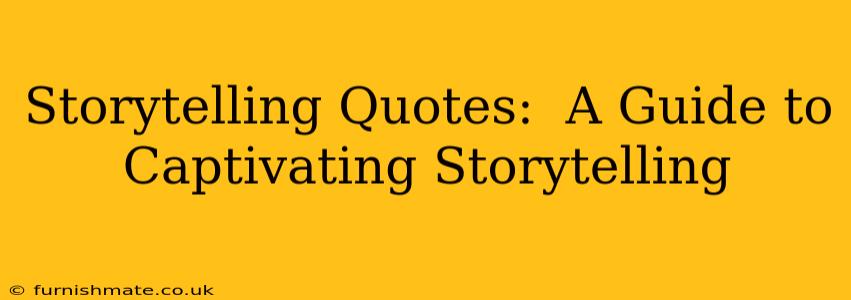Storytelling. It's the art of weaving words into tapestries of emotion, transporting listeners to different times and places, and connecting with them on a deeply human level. But what makes a story truly captivating? While there's no single formula, the wisdom of countless storytellers has been condensed into powerful quotes that offer guidance and inspiration. This guide delves into the essence of captivating storytelling, using insightful quotes as our compass.
What Makes a Story Captivating?
Many factors contribute to a compelling narrative. It's not just about the plot; it's about the characters, the setting, the pacing, and the emotional resonance. As the renowned author, Stephen King, wisely stated, "If you don’t have the time to read, you don’t have the time (or the tools) to write. Simple as that." This highlights the importance of immersing yourself in the art form before attempting to create your own masterpieces.
Beyond the technical aspects, the heart of captivating storytelling lies in its ability to connect with the audience on an emotional level. "The purpose of storytelling is to make the ordinary extraordinary, to make the mundane magical." While the author of this quote remains anonymous, its truth resonates deeply. We're drawn to stories that make us feel something, whether it's joy, sorrow, fear, or hope.
The Power of Character and Setting
A captivating story needs memorable characters. These aren't just cardboard cutouts; they're complex individuals with flaws, strengths, and compelling motivations. As novelist and screenwriter, William Goldman, observed, "A writer is someone for whom writing is more difficult than it is for other people." This highlights the constant work and refinement needed to create believable characters. The audience must invest in their journey, empathize with their struggles, and root for their success (or even their downfall, depending on the story's arc).
The setting, too, plays a vital role. A well-described environment adds depth and richness to the narrative, immersing the reader or listener in the story's world. Consider the evocative power of descriptions: the chill wind whistling through a desolate landscape, the vibrant colors of a bustling marketplace, the hushed reverence of an ancient cathedral. The setting isn't merely a backdrop; it's an integral part of the story's fabric.
How do I create believable characters?
Creating believable characters requires delving deep into their motivations, backstories, and relationships. Consider their strengths and weaknesses, their fears and aspirations. Give them quirks and habits that make them unique and relatable. Avoid stereotypical characters; strive for complexity and nuance. Researching real people and observing human behavior can be invaluable in developing believable characters.
How important is setting to a good story?
Setting is crucial because it establishes the atmosphere, mood, and context of the story. A well-developed setting can enhance the reader's immersion and emotional connection with the characters and plot. It can also serve as a symbolic representation of themes and conflicts within the narrative.
The Art of Narrative Structure
A captivating story needs a compelling narrative structure. This isn't simply a matter of beginning, middle, and end; it's about creating a sense of anticipation, suspense, and resolution. The pacing, the use of foreshadowing, and the revelation of information all contribute to the overall impact of the story. "Start with the end in mind." This quote, though often attributed to Stephen Covey, is equally applicable to storytelling. Having a clear vision of the story's climax helps to shape the narrative arc effectively.
What are the elements of a good story structure?
A good story structure typically includes a compelling inciting incident, rising action that builds suspense, a climax where the conflict reaches its peak, falling action, and a resolution that provides closure. Effective pacing, foreshadowing, and the strategic reveal of information are also crucial elements.
The Importance of Emotional Resonance
Ultimately, the most captivating stories are those that connect with the audience on an emotional level. They evoke feelings, spark empathy, and leave a lasting impression. "Writing is the painting of the voice." Voltaire’s words emphasize the power of storytelling to create vivid images and evoke emotions. The story should resonate with the reader long after they’ve finished reading.
Conclusion: The Enduring Power of Storytelling
Storytelling is a powerful tool, capable of inspiring, educating, and connecting us on a profound level. By understanding the principles outlined in these quotes and applying them to your own storytelling, you can craft narratives that captivate your audience and leave a lasting impact. Remember: it's not just about telling a story; it's about weaving a tapestry of words that resonates with the human heart.

